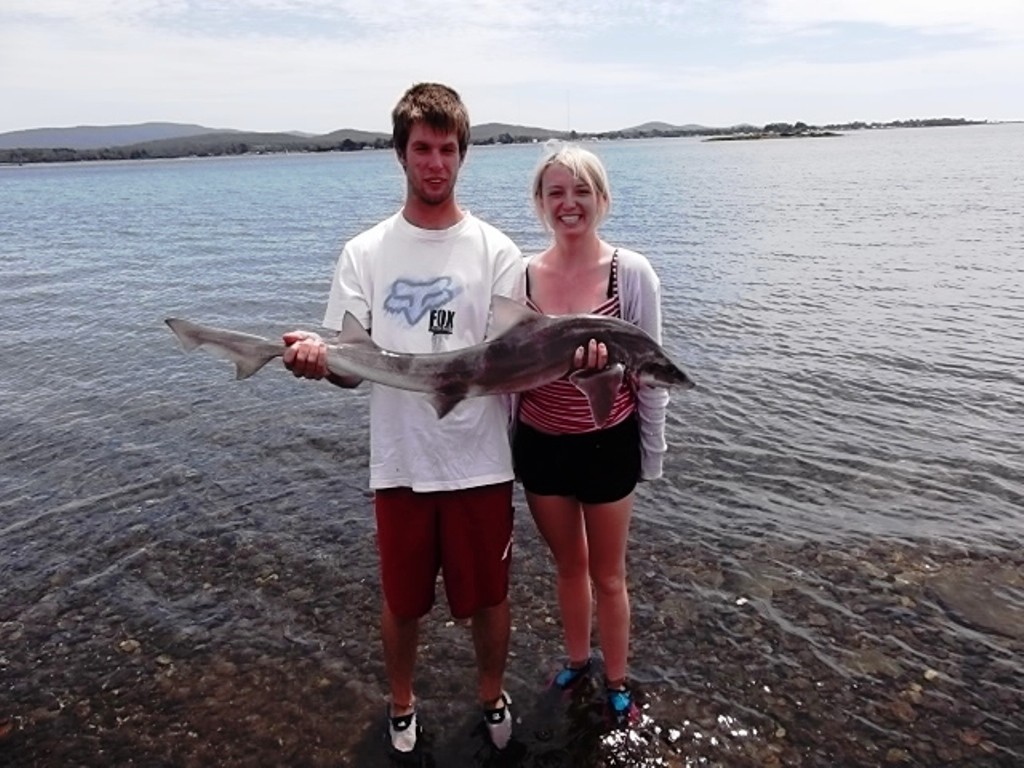Sharking along the North Coast
by Carl Hyland on 9 Oct 2012

Two lucky beach anglers with gummy. Carl Hyland
Whilst winter still lingers in some quarters of Tasmania, spring sunshine and warmer waters have seen an influx of predators along the North Coast of Tasmania.
Drifting whale carcasses, spent from mating and possible damage by shipping, provide a good food source for hungry sharks, big specimens too, like the 5-6 metre Great whites that inhabit the coastline from Baren Joey Island in the East to Port Sorell in the North west. Whilst great whites are protected, other species such as schools shark, seven gillers and gummy are fair game for anglers prepared to put in the time for a feed of ‘flake’.
Whether you are in a boat or fishing from a platform or pier or off the beach, shark fishing is great fun and can provide a lot of entertainment for young and older anglers. Gear need not be expensive, stout rods, good quality braid or mono will do the job but it’s the terminal tackle that will let you down, so I suppose that’s the most important part of shark fishing.
Rods
You’re not going to see me mention what rod is best or my favourite brand, because I don’t have one. Put simply, you need a stout rod if targeting shark off a beach. I use a 15’ two-piece fibreglass rod which is suitable for what I do as I have trouble casting a big rod as I have crook shoulders.
My 15 footer does the job and will suffice for the biggest fish as I catch anything from small salmon to three metre seven gilled sharks on it.
A nice long butt with a wooden spike on the bottom is good as it allows you to drive the rod into the sand or stand it upright in a piece of PVC pipe or a rod holding spike.
Good rod guides are also essential and check them regularly for wear and tear. If they are cracked, replace them as mono will often find a crack and make it worse or when you have that big fish on, the line will often fray or friction burr through the crack.
Look after your rod, mine are washed in warm soapy water after every outing and if you maintain them with a good clean now and then, they will last you for years. I even clean mine with wd40 on a rag when dry.
Reels
Fishing reels are an important tool. Yep, that’s right, they are tools. They can make a good fish capture easy or damned hard. You are there to fight the fish, not the reel. A good Alvey side caster is a great reel for shark fishing a sit can hold lots of line, plus it’s very easy to cast and you can get good distances. I use an ‘eggbeater’, in this case a 5500 long cast and it gets me out to where the fish are.
Line should be 15kg upwards and I prefer mono to braid in the surf as I find braid does tend to tangle in waves.
Bait
Bait should always be fresh. Even though sharks are scavengers, I find that they will often take a fresh bait more so than fish that have been frozen, anything from pilchards to salmon will suffice but the best shark bait and is a closely guarded secret amongst Tasmanian anglers (not any more) is freshwater eel. Don’t know what it is, but if cut into small portions, eel will out fish all other baits for gummy shark and seven gilled specimens. Another good thing about fish fillets or a whole fish as bait is that it deters pickers such as sea lice which can strip bait bare in minutes on some nights. Also wrapping your bait in a fish stocking such as bait mate, will prevent its hasty demise.
Wire is not essential in tracing system for sharks, but if I’m targeting bigger fish, I use light wire traces. If you are hunting gummies, a heavier mono leader attached to a swivel will get you some good fish. I’m a great believer in fishing light gear wherever possible.
Any shark caught should be dispatched quickly and cleanly if intended for the table. Without going into specifics, a tap on the head and a bleed out is essential and even a gummy of say one meter in length will put up a huge fight in the bottom of a tinny or on a beach. I carry a purpose built ‘club’ for this reason. Bleeding out is necessary as toxins are carried in sharks blood and I even cut the tails off and let the surf help wash them out. Removal of the liver will help with removing the ammonia taste and smell.
Next Week, we shall talk about hooks and how to rig baits for surf fishing.
If you want to link to this article then please use this URL: www.sail-world.com/102742